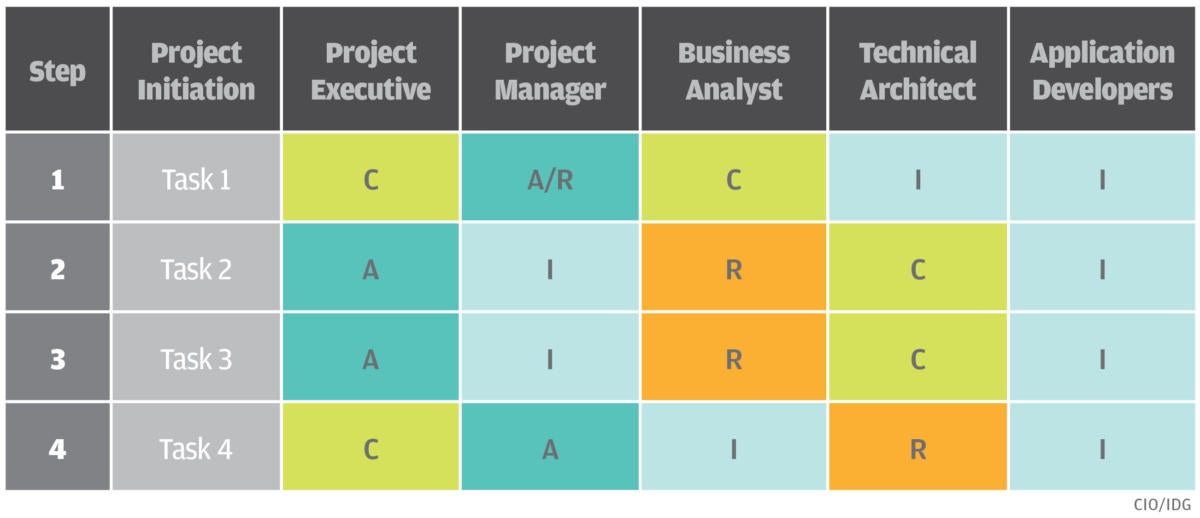Feature
Jun 07, 202411 mins
IT Governance FrameworksIT LeadershipProject Management Tools
A RACI matrix is a simple, effective means for defining project roles and responsibilities, providing a comprehensive chart of who is responsible, accountable, consulted, and informed every step of the way.
Having managed and rescued dozens of projects, and helped others do so, I’ve noted that there is always one critical success factor (CSF) that has either been effectively addressed or missed/messed up: clarity around the roles and responsibilities for each project participant and key stakeholder. No matter how detailed and complete a project plan may be for any project, confusion or omission of participant roles and responsibilities will cause major problems.
Enter the RACI matrix. The simplest and most effective approach I’ve seen and used to define and document project roles and responsibilities is the RACI model. Integrating the RACI model into an organization’s project life cycle (PLC) creates a powerful synergy that enhances and improves project outcomes.
What is a RACI matrix?
The RACI matrix is a project role and responsibility assignment chart that diagrams every task, milestone, or key decision to assign team roles across four categories: Responsible, Accountable, Consulted, and Informed. These categories indicate whether a team member is Responsible for an action item, is Accountable for it, should be Consulted on it, or simply be Informed of the action, milestone, or decision. The acronym RACI stands for the four roles that stakeholders might play at any point in a project.
The four roles that stakeholders might play in any project include the following:
Responsible: People or stakeholders who do the work. They must complete the task or objective or make the decision. Several people can be jointly Responsible.
Accountable: Person or stakeholder who is the “owner” of the work. He or she must sign off or approve when the task, objective or decision is complete. This person must make sure that responsibilities are assigned in the matrix for all related activities. Success requires that there is only one person Accountable, which means that “the buck stops there.”
Consulted: People or stakeholders who need to give input before the work can be done and signed-off on. These people are “in the loop” and active participants.
Informed: People or stakeholders who need to be kept “in the picture.” They need updates on progress or decisions, but they do not need to be formally consulted, nor do they contribute directly to the task or decision.
How to create a RACI matrix
The simple process for creating a RACI model includes the following six steps:
Identify all the tasks involved in delivering the project and list them on the left-hand side of the chart in completion order. For IT projects, this is most effectively addressed by incorporating the PLC steps and deliverables. (This is illustrated in the example below.)
Identify all the project stakeholders and list them along the top of the chart.
Complete the cells of the model identifying who has responsibility, accountability and who will be consulted and informed for each task.
Ensure every task has at least one stakeholder Responsible for it.
No tasks should have more than one stakeholder Accountable. Resolve any conflicts where there is more than one for a particular task.
Share, discuss and agree the RACI model with your stakeholders at the start of the project. This includes resolving any conflicts or ambiguities.
RACI matrix example
For purposes of simplification, let’s say your project can be broken down into four discrete tasks, undertaken by a team of application developers, along with a sponsoring project executive, project manager, business analyst, and technical architect.
Step 1 of the process involves mapping out the project as a whole. For this, the project manager is both accountable and responsible for the work at hand. To determine the scope and deliverables of the project, the project manager consults with the project’s executive sponsor and with the business analyst about the process to be overhauled as part of the project. The technical architect and the application developers are subsequently informed of the project plan.
In Step 2, the business analyst must then delve more deeply into the process to help map out each facet of the business process to be overhauled. The business analyst is thus responsible for the task, with the project executive being accountable for signing off on this work. To better understand the technical underpinnings of the current process, the business analyst will consult with the technical architect. The project manager and application developers will then be informed of the conclusions derived from this portion of the project.
Here is an illustration of a simplified RACI model for this example project, taking these first two steps into account:

The subsequent third and fourth tasks involve shaping the new process, again with the business analyst responsible for this work, and the other roles on the team following their same responsibilities when the old process was being analyzed in Step 2. Step 4 sees the technical architect taking over, devising a new architecture that will support the new process, signed off by the executive sponsor, and held accountable by the project manager, who devised the scope and deliverables in Step 1.
RACI matrix template
Templates are available for free on the web for those looking to get started with the RACI model. These are typically geared toward Microsoft Excel or Google Sheets, but can also be available for more specialized software. Here are several popular possibilities:
Vertex 42 Excel RACI templates
Projectmanager.com Excel RACI templates
Smartsheet Excel RACI templates
ClickUp RACI templates
Excel Downloads RACI templates
RACI vs. RASCI
RASCI is another type of responsibility assignment matrix used in project management. It retains the four core roles of RACI — Responsible, Accountable, Consulted, and Informed — but adds a fifth: Supportive. The Supportive role in a RASCI chart is responsible for providing assistance to those in the Responsible role. This may involve providing additional resources, expertise, or advice to help the Responsible party complete a particular task. Organizations that choose RASCI often do so to ensure that personnel who may not have direct responsibility or accountability but are nevertheless vital to the success of an activity or project are considered a notable facet (and cost) of the project. Individuals or entities that consult on a particular phase of a project, whether internal or external to the organization, provide an example of Supportive resources.
RACI matrix rules and best practices
Simply creating a RACI matrix is not enough. You must ensure that the matrix maps to a successful strategy. Here, certain rules should be followed, and conflicts and ambiguities in the plan must be hammered out.
When building out your RACI matrix, the following three rules should be applied:
Every task must have at least one Responsible party.
To ensure clear decision-making, each task should have only one Accountable person.
Every team member should have a role on each task, even if it is just to be Informed.
Resolving conflicts and ambiguities in a RACI matrix involves looking across each row and up and down each column for the following:
Analysis for each stakeholder:
Are there too many R’s: Does one stakeholder have too much of the project assigned to them?
No empty cells: Does the stakeholder need to be involved in so many of the activities? Can Responsible be changed to Consulted, or Consulted changed to Informed? I.e., are there too many “cooks in this kitchen” to keep things moving? (And if so, what does that say about the culture within which this project is being managed?)
Buy-in: Does each stakeholder totally agree with the role that they are specified to play in this version of the model? When such agreement is achieved, that should be included in the project’s charter and documentation.
Analysis for each PLC step or deliverable:
No R’s: Who is doing the work in this step and getting things done? Whose role is it to take the initiative?
Too many R’s: Is this another sign of too many “cooks in this kitchen” to keep things moving?
No A’s: Who is Accountable? There must be one ‘A’ for every step of the PLC. One stakeholder must be Accountable for the thing happening — “the buck stops” with this person.
More than one A: Is there confusion on decision rights? Stakeholders with accountability have the final say on how the work should be done and how conflicts are resolved. Multiple A’s invite slow and contentious decision-making.
Every box filled in: Do all the stakeholders really need to be involved? Are there justifiable benefits in involving all the stakeholders, or is this just covering all the bases?
A lot of C’s: Do all the stakeholders need to be routinely Consulted, or can they be kept Informed and raise exceptional circumstances if they feel they need to be Consulted? Too many C’s in the loop really slows down the project.
Are all true stakeholders included in this model: Sometimes this is more of a challenge to ensure, as it’s an error of omission. This is often best addressed by a steering committee or management team.
RACI matrix in project management
It is the above analyses, which are readily enabled by the use of a RACI matrix, that deliver the real benefit of the model. It is the integration of the model with a specific PLC that ensures that the project is structured for success. Without either component, problems with the structure of the project management process may remain hidden until (or even while…) they cause the project to bog down. Making the time and effort to create a customized PLC/RACI for each significant project is an opportunity to design your project management process for project success.
SUBSCRIBE TO OUR NEWSLETTER
From our editors straight to your inbox
Get started by entering your email address below.
>>> Read full article>>>
Copyright for syndicated content belongs to the linked Source : CIO – https://www.cio.com/article/287088/project-management-how-to-design-a-successful-raci-project-plan.html































